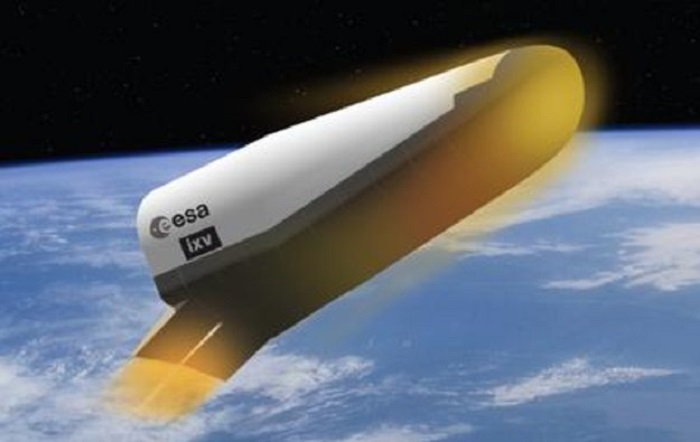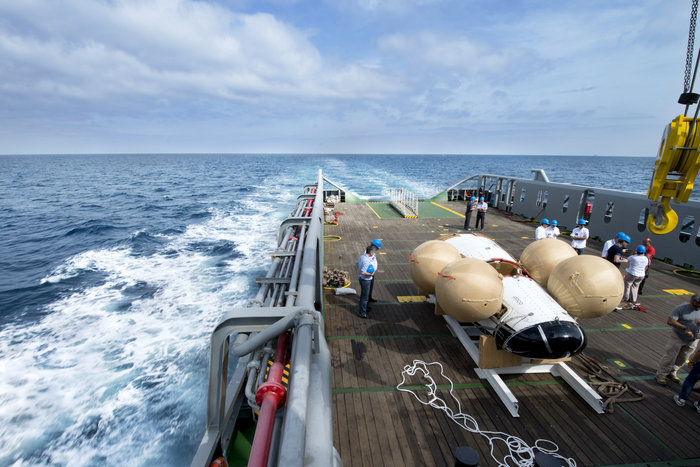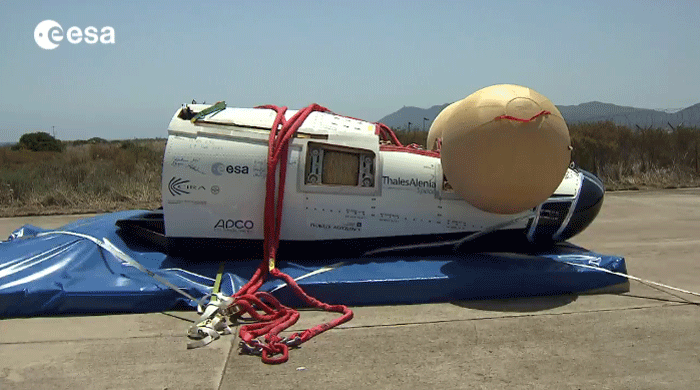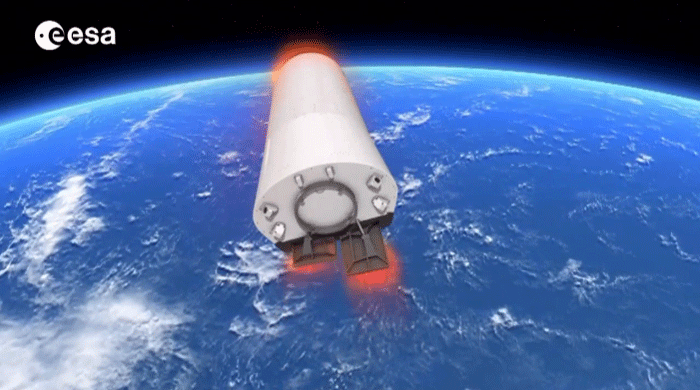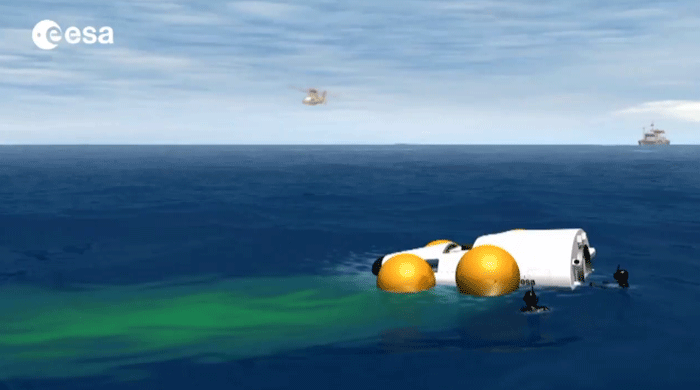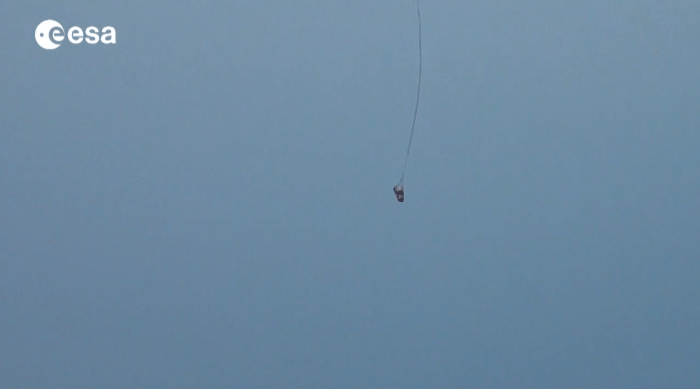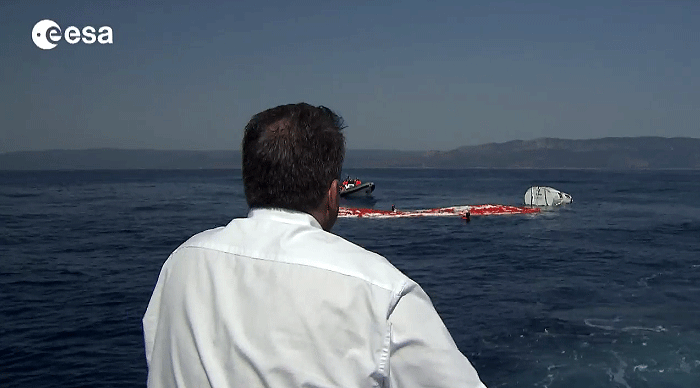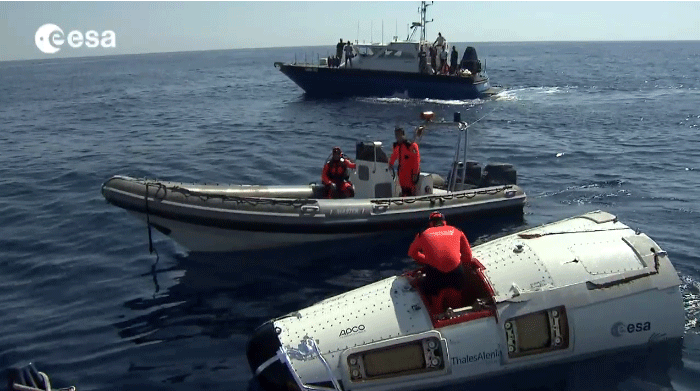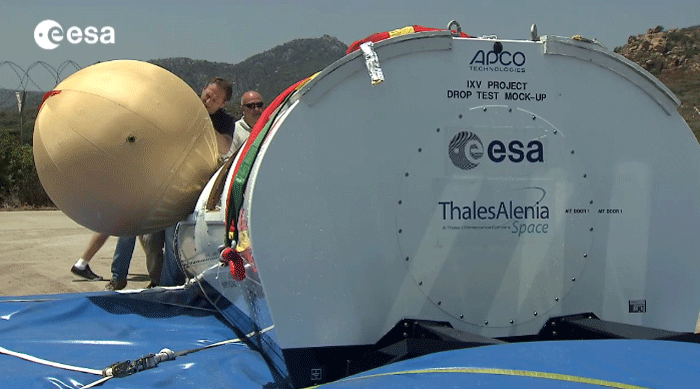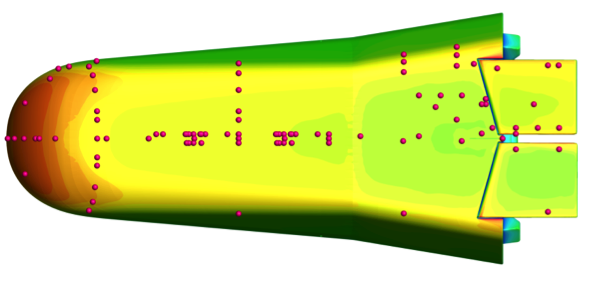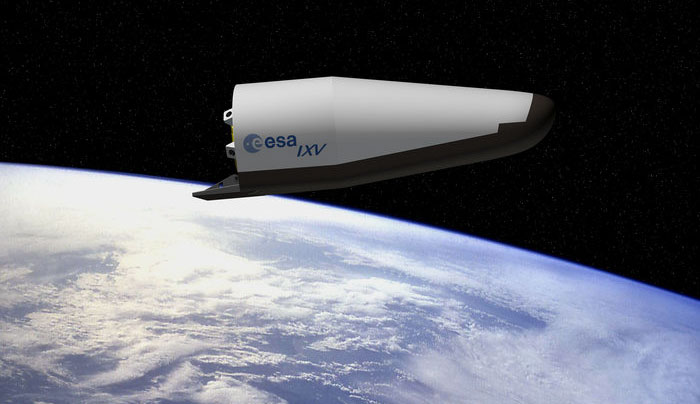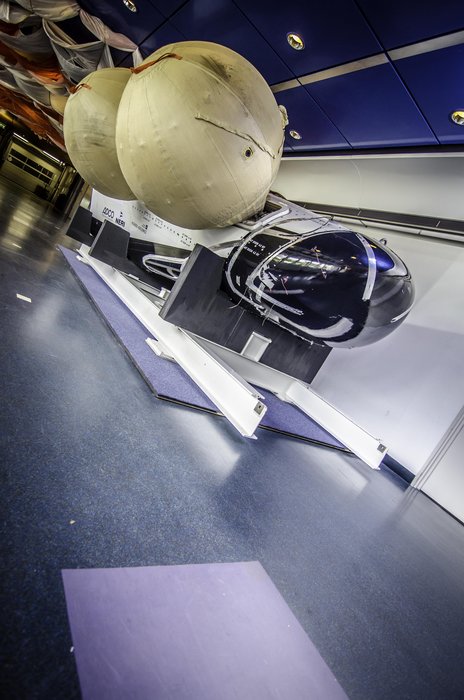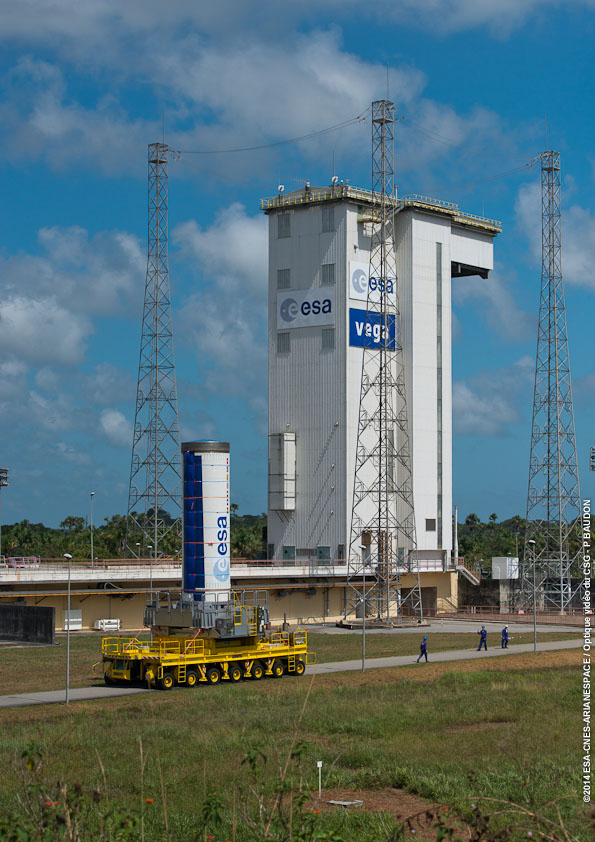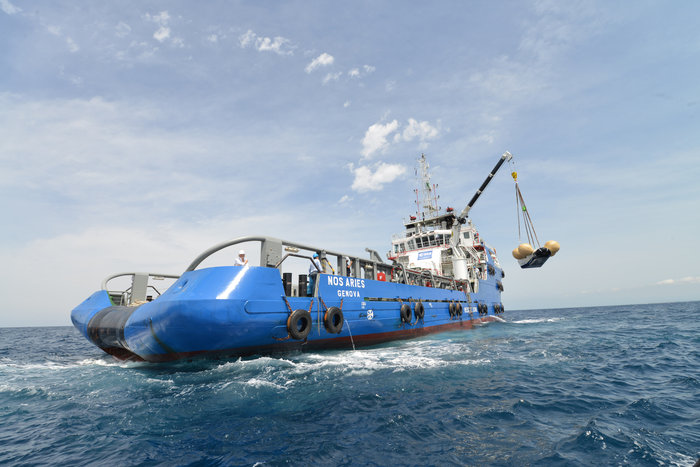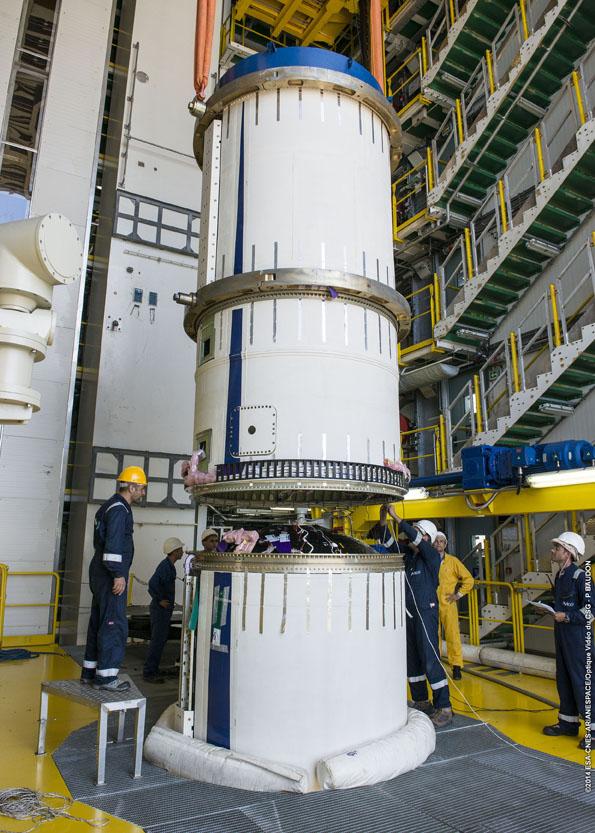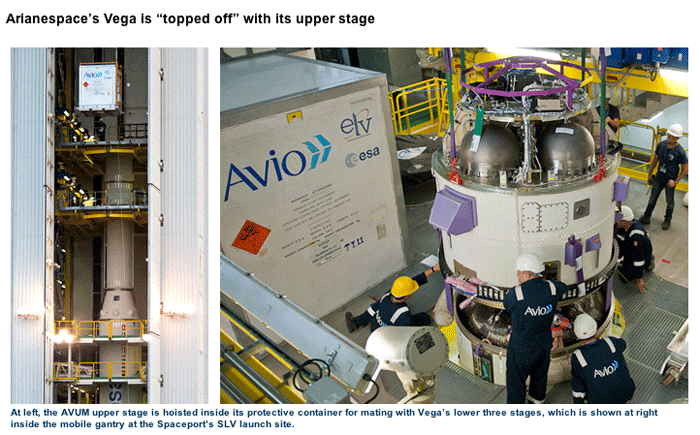.
Several technologies contribute to the consolidation of the European knowledge base for future reentry missions. Among the most important ones:
- Aerothermodynamics – validation of design tools and improvement of design performance, since the current lack of precise knowledge about phenomena occurring during re-entry induces the need for additional design margins. In fact, when re-entering from low Earth orbit (LEO) the oxygen and nitrogen molecules in the air break apart to dissipate the high energies involved. When this happens, the ideal-gas laws normally used for simulations are replaced by complex, real-gas laws that are governed by phenomena that are difficult to predict.
- Guidance Navigation and Control (GNC) – improvement of the guidance algorithms, coupling of inertial measurement units with GPS for navigation, exploration of the combination of flaps and thrusters for flight control, addressing complex GNC issues related to the hypersonic phase of a reentry from LEO.
- Thermal Protection and Hot Structures – validation of the flight performance of thermal protection materials and complex design solutions (for example, thermal expansion, junctions between materials, seals, gaps, steps and singularities), addressing the complexities introduced by the severe thermo-mechanical environment for LEO reentry applications.
The Intermediate eXperimental Vehicle (IXV) project objectives tackle the basic European needs for reentry from LEO, consolidating the knowledge necessary for the development of any future European reentry system while allowing risk limitation. Its end-to-end European mission on the Vega launcher is planned for 2014.
.
Erfolgreiche Wasserung für das Intermediale Experimental Vehicle (IXV)
.
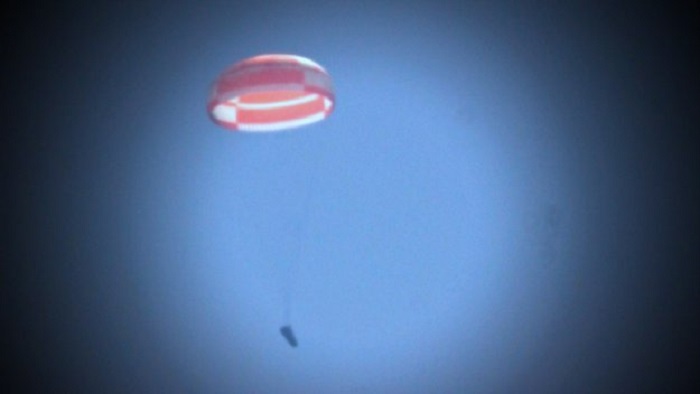
.
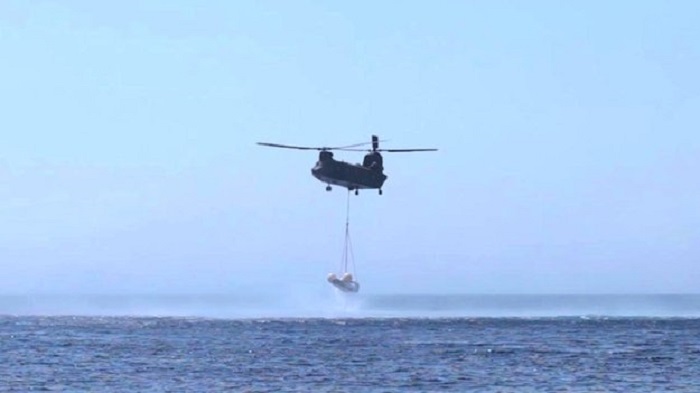
ESA’s experimental reentry vehicle passed its milestone descent and landing test on Wednesday at the Poligono Interforze Salto di Quirra off the east coast of Sardinia in Italy.
The full-scale Intermediate eXperimental Vehicle (IXV) prototype was released from an altitude of 3000 m by a helicopter, falling to gain speed to mimic a space mission before parachute deployment. The parachute slowed IXV for a safe splashdown in the sea at a speed below 7 m/s.
This last step in a series of tests shows that IXV can be recovered safely after its mission into space.
The IXV project is developing and flight-testing the technologies and systems for Europe’s future autonomous atmospheric reentry vehicles.
It will be launched by ESA next year on Vega, Europe’s new small launcher, into a suborbital path. It will reenter the atmosphere as if from a low-orbit mission, testing new European reentry technologies during its hypersonic and supersonic flight phases.
Previous campaigns included several water impact tests at CNR–INSEAN, a marine-engineering research institute in Rome, Italy. An instrumented subscale prototype was released at various angles and speeds to assess the best configuration for minimum impact loads.
At the Yuma Proving Ground in Arizona, USA, the multistage supersonic parachute was qualified up to the opening of the main subsonic stage.
Building on these, Wednesday’s test started with the redeployment of the main subsonic parachute followed by: cutting the two ablative thermal protection covers of the parachute bridles, firing the 16 non-explosive actuators to release the four panels covering the floatation balloons, jettisoning the panels, detecting the water impact, deploying the beacons, and receiving the signal from the Cospas–Sarsat satellite network pinpointing the prototype bobbing in the sea.
An anomaly in inflating the balloons will be investigated. The vehicle was recovered from the sea and taken to land for detailed inspections and analysis.
This test highlights the importance of early inflight verification to secure a robust space vehicle design, confirming the technical direction and possibly suggesting further improvements.
Quelle: ESA
.
Update: 2.01.2014
.
Space launch highlights for 2014
Later in the year, it will launch ESA’s experimental IXV vehicle into a sub-orbital flight to test new technologies during its hypersonic and supersonic flight phases before the spacecraft lands in the Pacific.
.
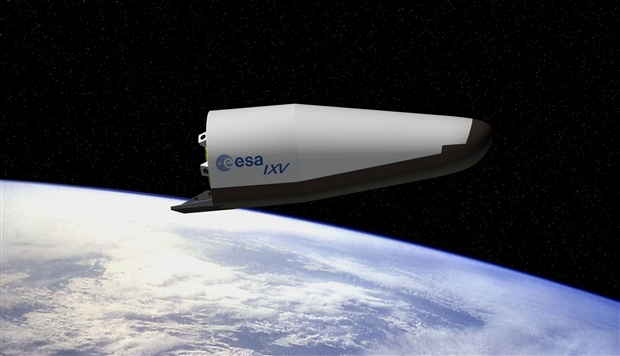
ESA's experimental IXV vehicle is due to make its first sub-orbital test flight in 2014, launched by a Vega rocket.
.
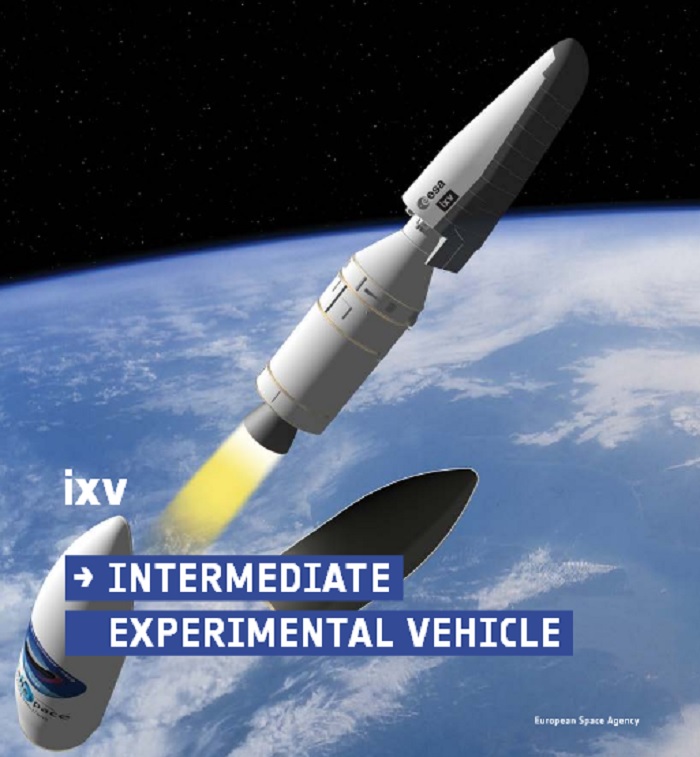
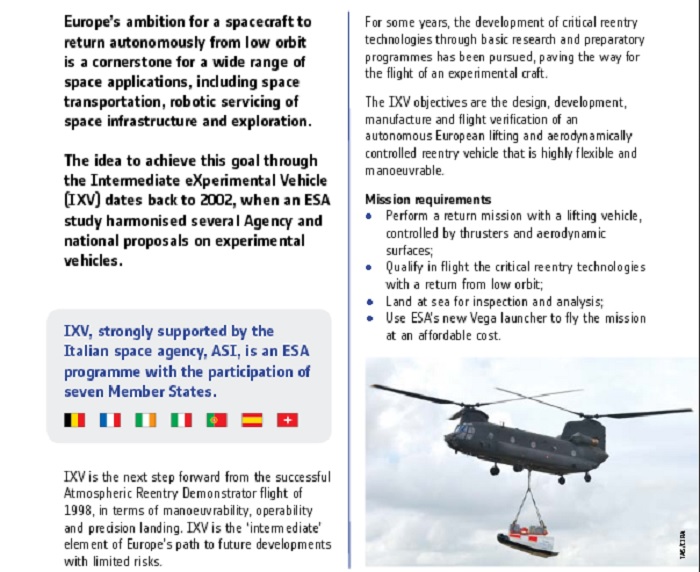
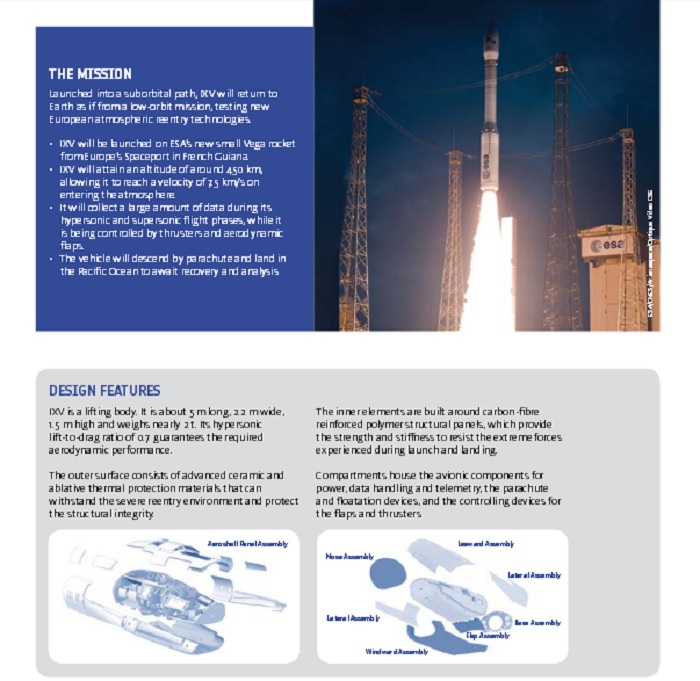
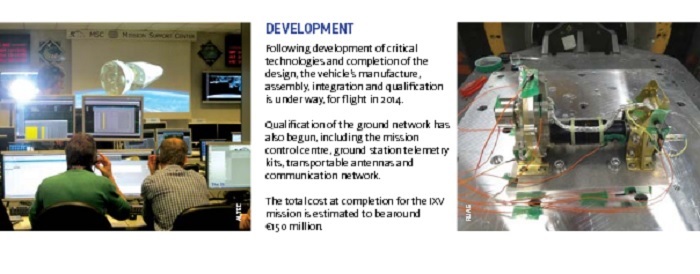
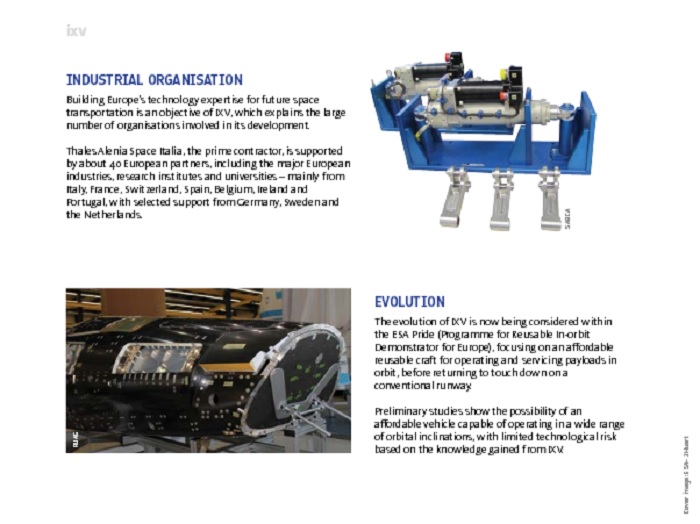
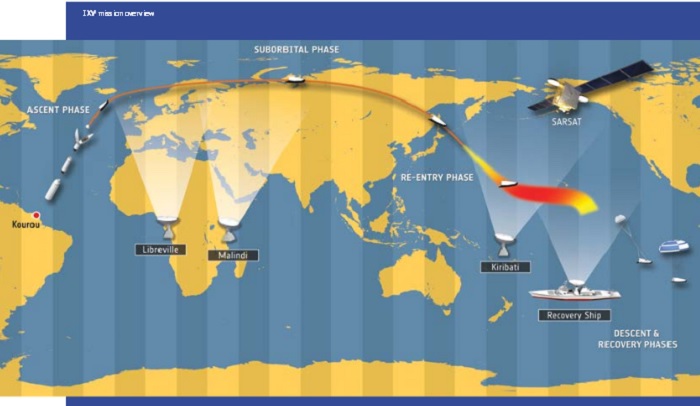
Quelle: ESA
.
siehe auch: /_blog/2013/07/31/raumfahrt---esa-setzt-auf-kleinen-raumgleiter-nach-schluessel-studie-der-technologiedemonstrators-ixv/
.
Update: 25.06.2014
.
Flugtest von ESA´s Intermediate Experimental Vehicle (IXV)
.Z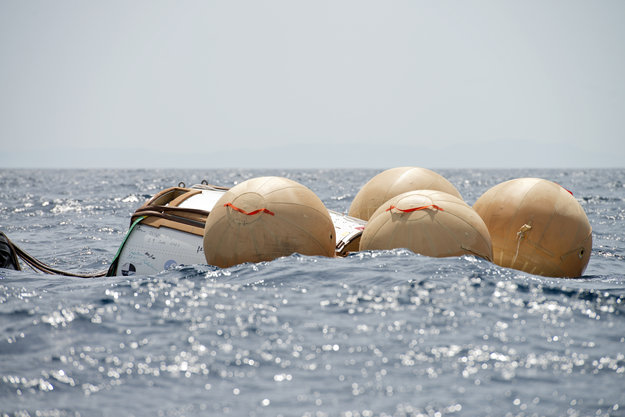
Balloons keep IXV afloat
.
Yesterday, the ship and crew aiming to recover Europe’s unmanned IXV spacecraft in November had a practice run off the coast of Tuscany, Italy.
They retrieved a prototype of the suborbital IXV Intermediate eXperimental Vehicle, the same model flown last year in a splashdown test off the east coast of Sardinia.
A crane dropped the two-tonne vehicle into the water for the crew to practise the tricky manoeuvres they will use when the real thing splashes down in the Pacific Ocean later this year. The rehearsal even allowed for an upside-down splashdown.
A crew from the Italian company NERI were operating the recovery ship Nos Aries while the prototype was carefully hoisted aboard and into its container. This model, its work done, will now be taken to ESA’s Technical Centre in the Netherlands for display.
Launched later this year on ESA’s Vega rocket from Kourou, French Guiana, IXV will test technologies and systems for Europe’s future autonomous atmospheric reentry vehicles.
Descending on its suborbital path, as if returning from low orbit, IXV will use its body to generate lift for flying, controlled only by aerodynamic flaps and thrusters.
It is packed with new technology to collect information on aerodynamics, aerothermodynamics, materials, structures, mechanisms, guidance, navigation, control and avionics.
The experimental flight will end with IXV transmitting its precious information before splashing down into the most remote region of the Pacific, where Nos Aries will be waiting to retrieve it.
.
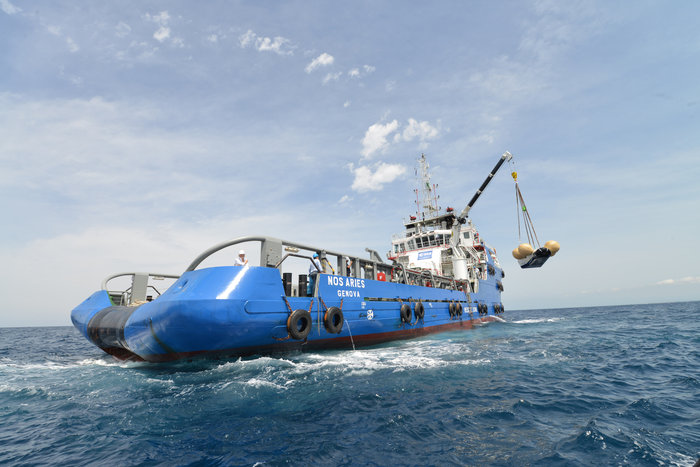
On the 23 June 2014 a prototype of the suborbital IXV Intermediate eXperimental Vehicle was recovered off the coast of Tuscany, Italy in a practice run for the launch of the real spacecraft in November.
A crane dropped the two-tonne vehicle into the water for the crew to practise the tricky manoeuvres. The rehearsal even allowed for an upside-down splashdown.
.
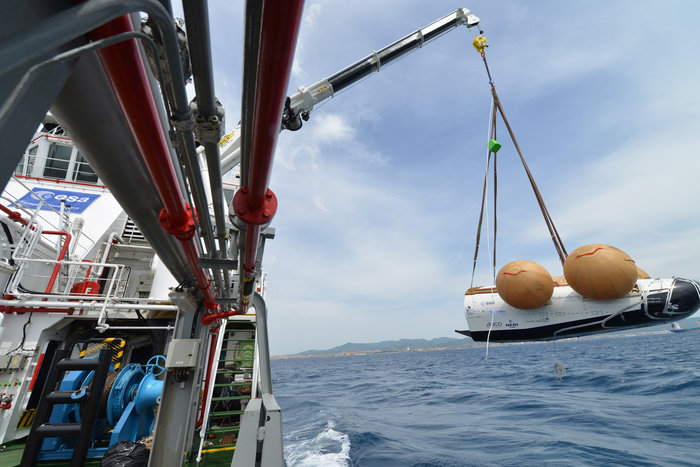
On the 23 June 2014 a prototype of the suborbital IXV Intermediate eXperimental Vehicle was recovered off the coast of Tuscany, Italy in a practice run for the launch of the real spacecraft in November.
The prototype was carefully hoisted onto the recovery ship Nos Aries and into its container.
.
Setting off in mid-summer, Nos Aries will leave Italy to cross the Mediterranean Sea and the Atlantic. The specialist crew will board in Panama for the month-long journey through the Panama Canal and Pacific.
Before launch, the ship will release weather balloons to check the wind conditions over the Pacific to provide information on IXV’s descent path.
If sea conditions allow the launch to go ahead, Nos Aries will receive the flight data from IXV’s 300 sensors during descent and then pick up the beacon signals to pinpoint the craft after splashdown.
Divers on speedboats will approach the floating craft and then stand back as robotic sniffers check for residual propellant fumes. On the all-clear, the recovery cranes will carefully lift IXV to safety before the fuel tank is cleaned out for the journey home to Europe.
.
On the 23 June 2014 a prototype of the suborbital IXV Intermediate eXperimental Vehicle was recovered off the coast of Tuscany, Italy in a practice run for the launch of the real spacecraft in November.
The prototype was carefully hoisted onto the recovery shipNos Ariesand into its container.
.
ESA’s experimental reentry vehicle passed its milestone descent and landing test on June 19, proving that IXV can be recovered safely after its mission into space. The real vehicle will be launched next year on Vega, Europe’s new small launcher, into a suborbital path, testing new European reentry technologies during its hypersonic and supersonic flight phases.
.
FRAMS ESA-Video
.
Quelle: ESA
.
Update: 4.07.2014
.
ESA’s experimental space plane gearing up for November debut
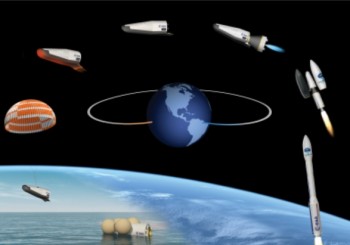
The European Space Agency (ESA) Intermediate eXperimental Vehicle (IXV) is enjoying a stay in Holland ahead of being shipped to Kourou, French Guiana to meet up with her Vega launch vehicle. The IXV space plane is in the Netherlands for a “shaking”, simulating the vibrations and stresses she can expect to endure atop of Vega during the November launch.
IXV:
The IXV will demonstrate Europe’s advanced re-entry technologies and integrated system design capabilities, via a reference mission that calls for a lift off from Europe’s Spaceport in Kourou, French Guiana, aboard a Vega launch vehicle.
The mission will conclude via a fully automatically controlled re-entry, descent and landing in the Pacific Ocean.
The spacecraft is about the size of an average car and weighs almost two tons when fully fuelled.
ESA managers note that knowledge gained from IXV may lead to building an affordable reusable craft capable of operating modular payloads for multiple applications in various orbits, before it returns to Earth to touch down on a conventional runway.
Applying such a vehicle into missions for ESA could include the servicing of orbital infrastructures and future generations of satellites, within ESA’s tight budget.
She could also be used for microgravity experiments, Earth sciences, Earth observation and robotic exploration.
Preparations for the debut flight have been ongoing since 2007, when contracts were signed to bring the space plane to life. The spacecraft is now at the business end of her flow toward lauch, following IXV integration and qualification work in Turin, Italy.
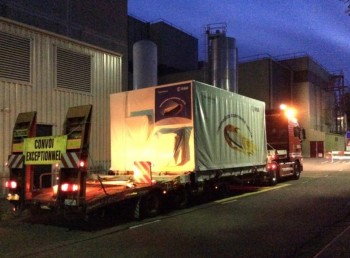
Following a road trip, the space plane is now enjoying a stay in the Netherlands for IXV environmental testing that will continue until September.
The test requirement saw the space plane arrive via truck at ESA’s Technical Centre in Noordwijk – ahead of the first batch of testing that is scheduled for three weeks, starting on July 11.
The IXV will be bolted down on to a ‘shaker table’ to experience the heavy vibrations of launch. There will also be three days of ‘separation shock’ testing, mimicking the moment the craft separates from the Vega rocket.
At an altitude of 320 km, a pyrotechnic device will fire to open a clamp band for springs to push IXV away from the upper stage.
Mission planners must be sure that she can withstand the mechanical shock of the pyrotechnic detonation, ESA noted.
Launched into a suborbital trajectory from Kourou, the IXV will return to Earth as if from a low-orbit mission, allowing for the testing and qualification of new critical technologies for future reentry vehicle concepts.During it mission, the vehicle will attain an altitude of around 450 km, allowing it to reach a velocity of 7.5 km/s.
She will then enter the atmosphere and collect a large amount of data during its hypersonic and supersonic flight, while she is being controlled by thruster firings and her aerodynamic flaps.
The Nos Aries and crew – tasked with recovering the IXV spacecraft – have already undertaken a practice run off the coast of Tuscany, Italy – where they retrieved a prototype from the water, the same model flown last year in a splashdown test off the east coast of Sardinia.
“A crew from the Italian company NERI were operating the recovery ship Nos Aries while the prototype was carefully hoisted aboard and into its container,” ESA noted.
“This model will now be taken to ESA’s Technical Centre in the Netherlands for display.”
This ship will have an important role to play throughout the mission, releasing weather balloons to check the wind conditions over the Pacific to provide information on IXV’s descent path.
The crew will also receive the flight data from IXV’s 300 sensors during descent and then pick up the beacon signals to pinpoint the location of the craft after splashdown.
Divers on speedboats will approach the floating craft and then stand back as robotic sniffers check for residual propellant fumes, prior to her recovery.
Quelle:NS
.
Update: 16.07.2014
.
IXV FINAL TESTS
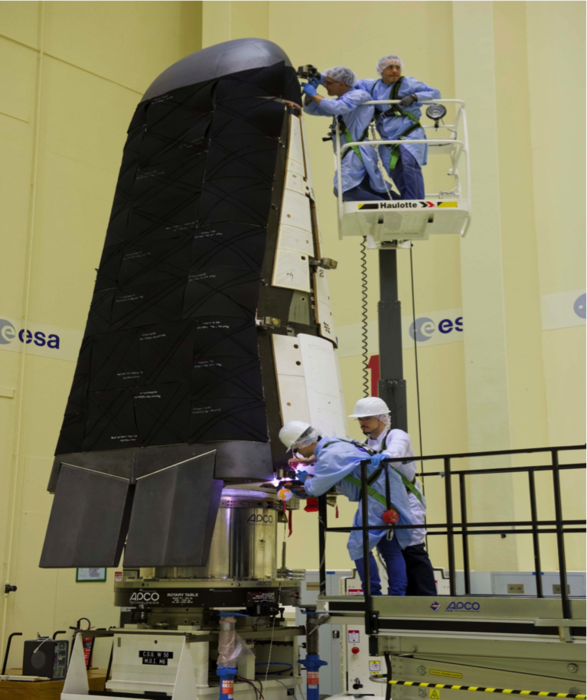
Engineers are forging ahead with the final tests on ESA’s Intermediate eXperimental Vehicle, IXV, to check that it can withstand the demanding conditions from liftoff to separation from its Vega launcher in November 2014.
.
All eyes are on ESA’s spaceplane to showcase reentry technologies after its unconventional launch on a Vega rocket this November.
Instead of heading north into a polar orbit – as on previous flights – Vega will head eastwards to release the spaceplane into a suborbital path reaching all the way to the Pacific Ocean.
Engineers are forging ahead with the final tests on ESA’s Intermediate eXperimental Vehicle, IXV, to check that it can withstand the demanding conditions from liftoff to separation from Vega.
Launched in early November, IXV will flight test the technologies and critical systems for Europe’s future automated reentry vehicles returning from low orbit. This is a first for Europe and those working in the field are keeping a close watch.
The research and industrial community have the chance to use this information for progress in atmospheric reentry, oriented towards transportation systems with applications in exploration, science, Earth observation, microgravity and clean space.
Jose Longo, ESA’s head of aerothermodynamics, said, “The technical advancements that have been made since the first experiments with our Atmospheric Reentry Demonstrator in 1996 are huge,”
.
ESA’s Intermediate eXperimental Vehicle, IXV, has 300 sensors that will gather data during its suborbital path back to Earth.
.
“This is the first flight demonstration of features such as highly advanced thermal structures: thrusters and flaps that are part of the control system, and the 300 sensors and infrared camera to map the heating all along the spacecraft from the nose to the flaps. These things just cannot be tested in the same way in laboratories.”
“The fact that ESA’s IXV will be launched on Vega makes this a fully European mission,” noted Stefano Bianchi, ESA’s head of launchers development.
IXV weighs almost two tonnes, close to Vega’s lifting capacity, and will be a tight fit inside the vehicle’s fairing.
“In this mission we are not only monitoring the spacecraft all along its autonomous flight, but also tracking its progress back to Earth to a particular spot – this is different to what we are used to,” said Giorgio Tumino, ESA’s IXV project manager.
When IXV splashes down in the Pacific at the end of its mission it will be recovered by ship and returned to Europe for detailed analysis to assess the performance and condition of the internal and external structures.
The actual performance will be compared with predictions to improve computer modelling of the materials used and the spaceplane’s design.
Such is the enthusiasm and interest of industry in the opportunities associated with reentry technologies that the third IXV workshop in ESA’s Technical Centre, ESTEC, in Noordwijk, the Netherlands was packed out last week.
“It is very encouraging to see such interest in this programme,” added Giorgio. “Follow-up activities to this mission will build on the current industrial organisation and associated technologies will provide opportunities to newcomers.”
,
Artist impression of ESA's Intermediate eXperimental Vehicle (IXV)
.
Quelle: ESA
.
Update: 20.07.2014
ESA's IXV Spaceplane Readied for November Flight, While US Spaceplanes Pass Milestones
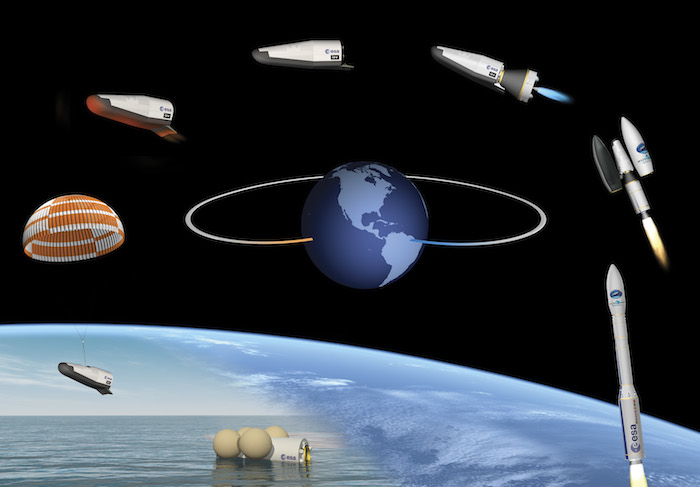
From the European Space Agency (ESA): “[The IXV] will be launched by ESA in 2014 on Vega, Europe’s new small launcher, into a suborbital path, from Europe’s Spaceport in French Guiana. After being launched into space, IXV will return to Earth as if from a low-orbit mission, testing brand-new European atmospheric reentry technologies during its hypersonic and supersonic flight phases.” Image Credit: ESA–J. Huart
.
There is a famous quote that states, “Once you have tasted flight, you will forever walk the earth with your eyes turned skyward, for there you have been, and there you will always long to return.” It appears that several organizations still have their “eyes turned skyward.” The space shuttle era may have come to a close a little over three years ago, but the spaceplane era is still very much underway.
The European Space Agency (ESA) announced this week that its Intermediate eXperimental Vehicle (IXV) is in its final testing phase in anticipation of its rocket-powered November flight. The flight is meant to investigate the conditions the vehicle will encounter during atmospheric reentry, and to test critical systems needed to return Europe’s future automated reentry vehicles. In addition, several U.S. spaceplanes—including Dream Chaser and the X-37B—have passed milestones in development and in flight.
The IXV spaceplane will be lofted aboard a Vega rocket from a launch site at the Guiana Space Centre in French Guiana. Previous Vega launches have taken payloads into a polar orbit, but according to the ESA this launch will see Vega head east as it takes the IXV on a suborbital trajectory. Outfitted with hundreds of sensors and an infrared camera, the spacecraft will reenter over the Pacific Ocean and will be recovered by a ship.
At present time, the IXV is being tested to check that it will withstand launch and separation, which is especially demanding on a spacecraft. At a size of approximately 1,800 kilograms (4,000 pounds), the vehicle is nearly at the weight limit for the Vega launch vehicle and has been described as a “tight fit” for the launcher’s fairing.
This test mission is essential in that it will test technologies in a manner that cannot be replicated on Earth. Jose Longo, ESA’s head of aerothermodynamics, underscored that sentiment:
“The technical advancements that have been made since the first experiments with our Atmospheric Reentry Demonstrator in 1996 are huge. This is the first flight demonstration of features such as highly advanced thermal structures: thrusters and flaps that are part of the control system, and the 300 sensors and infrared camera to map the heating all along the spacecraft from the nose to the flaps. These things just cannot be tested in the same way in laboratories,” Longo related.
The IXV hearkens back to a canceled spaceplane CNES (France’s space agency) and the ESA were developing throughout the 1980s and early 1990s. Hermes, described as Europe’s answer to the U.S. space shuttle, was intended to be launched on an Ariane rocket into low-Earth orbit with the objective of rendezvousing with space stations and deploying payloads. However, as costs skyrocketed and the size of the plane grew, the project never saw the light of day. A short history of Hermes is detailed in a previous AmericaSpace article by this author.
The IXV announcement comes days after the Sierra Nevada Corporation (SNC) stated their spaceplane, Dream Chaser, had passed a NASA Commercial Crew milestone. On July 8, SNC announced it had “completed a major Main Propulsion System (MPS) and Reaction Control System (RCS) risk reduction milestone for the Dream Chaser Space System, maturing the design of each system close to Critical Design Review (CDR).” SNC is one of three private companies currently developing spacecraft to shuttle crews into low-Earth orbit (the other two are Boeing and SpaceX, which are respectively developing the CST-100 capsule and the Dragon spacecraft).
In military spaceplane news, the X-37B spacecraft, manufactured by Boeing and used by the United States Air Force, is coming up on nearly 600 days in space (at present time, it has clocked 585 days in orbit). This “secret” spaceplane launched from Cape Canaveral Air Force Station aboard an Atlas V launch vehicle on Dec. 11, 2012.
A previous AmericaSpace article written by Ben Evans during that time stated: “The X-37B’s deployable solar array enables it to ‘loiter’ in low-Earth orbit for far longer than the shuttle could ever achieve. With two missions behind it—the first of which lasted 224 days, the second 469—it remains to be seen how long OTV-3 will remain aloft.” An article published this week on Space.com detailed the U.S. military’s effort to develop a spaceplane that could launch payloads.
While the remaining space shuttles may now be museum pieces, efforts by the ESA, Sierra Nevada, and the U.S. military have shown that spaceplanes are not just things of the past. In November, eyes will again turn skyward as the IXV makes its test voyage.
Quelle: AS
.
Update: 4.09.2014
.
This drop-test model of ESA’s IXV Intermediate eXperimental Vehicle will be among the attractions on display at this year’s ESTEC Open Day on 5 October.
IXV’s sleek lifting body design gives a clue to its purpose: the flight version will be launched 420 km into space this November by a Vega rocket before beginning a long glide back through the atmosphere.
In the process, IXV will gather data on reentry conditions to help guide the design of future spaceplanes.
The IXV replica seen here was last year dropped by helicopter into the Mediterranean to demonstrate that the design would endure splashdown – note the flotation balloons.
The flight model, meanwhile, has been put through its paces at ESA’s test centre next door, with everything needed to recreate every aspect of the launch and space environment under one roof.
Quelle: ESA
.
Update: 20.09.2014
.
Arianespace bereitet Vega-Rakete für Europäischen Raumgleiter IXV Mission vor.
.
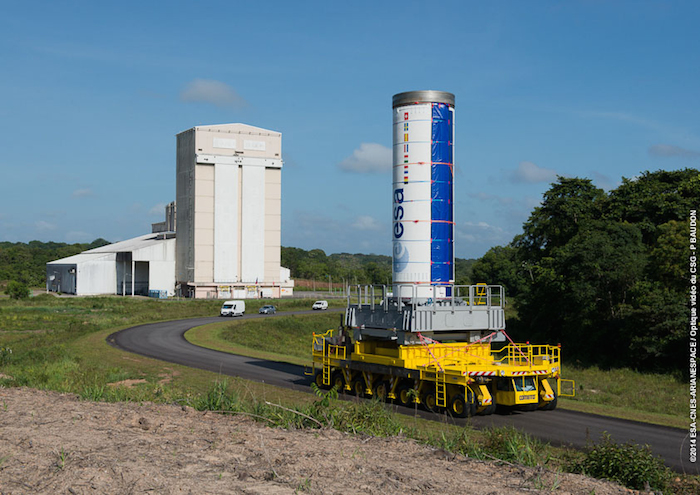
The transfer of Vega’s first stage is shown in these photos, beginning with its rollout from the Spaceport’s Booster Integration Building (at left). It arrives at the SLV launch site, where the multi-stage Vega will be assembled inside a protective mobile gantry (photos at center, and right).
.
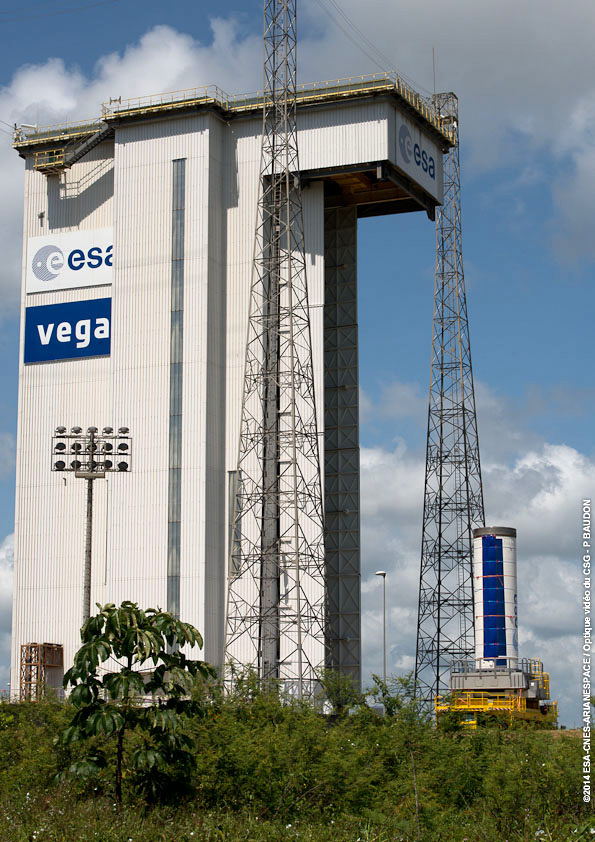
Vega FLIGHT VV04
Another lightweight Vega launcher has begun its build-up at the Spaceport, initiating preparations for Arianespace’s mid-November liftoff from French Guiana with the European Space Agency’s Intermediate eXperimental Vehicle (IXV).
The initial processing step occurred yesterday with Vega’s first stage rollout. This used a wheeled platform to transfer the solid-propellant stage from the Spaceport’s Booster Integration Building to the SLV launch site.
Once fully assembled, Vega will be ready to receive the IXV spaceplane, which is an atmospheric reentry demonstrator designed to FLIGHT test technologies and critical systems for Europe’s future automated reentry systems as they return from low Earth orbit.
IXV is Europe’s first spacecraft of this type, and the mission calls for a new Vega FLIGHT profile. Instead of heading north from the Spaceport into a polar orbit as on previous launches, Vega will follow an eastward trajectory – a suborbital path that ends with a parachute-assisted splashdown in the Pacific Ocean.
The IXV demonstrator features advanced aerodynamics with its lifting body design, which maximizes maneuverability. Built by Thales Alenia Space, the spaceplane integrates a sophisticated guidance, navigation and control system for the reentry phase, while a heat shield is used to withstand the heat of reentry.
November’s Vega mission with IXV is designated FLIGHT VV04 in Arianespace’s launcher family numbering system – signifying the launcher’s fourth mission to be performed from the Spaceport. Previous flights were conducted in April 2014 (with the Republic of Kazakhstan’s KazEOSat-1/DZZ-HR Earth observation satellite), in May 2013 (carrying a trio of satellites: Proba-V, VNREDSat-1 and ESTCube-1), and in February 2012 (with the LARES laser relativity satellite, the ALMASat-1 technology microsatellite demonstrator and seven CubeSats).
.
Update: 24.09.2014
.
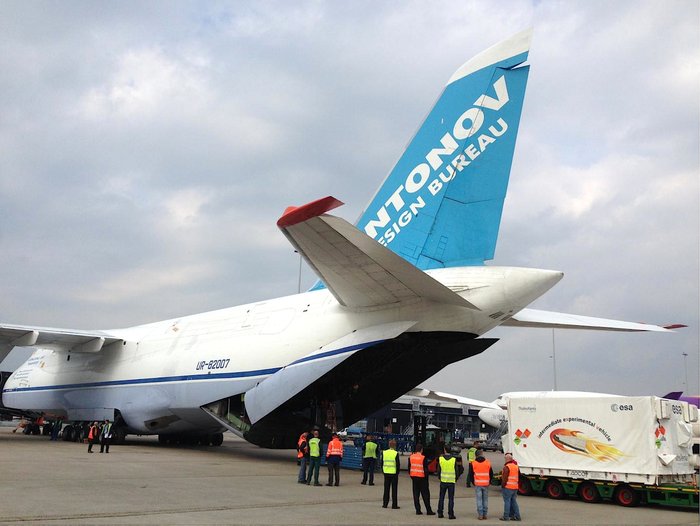
The Intermediate eXperimental Vehicle left the Netherlands from Schiphol airport on 23 September 2014 for the launch site in French Guiana.
.
The Intermediate eXperimental Vehicle is ready to fly and left the Netherlands today for the launch site in French Guiana.
In preparation for its arrival, the first stage of the Vega rocket that will loft IXV has already been moved to the launch pad. This marks the beginning of the campaign for Vega’s fourth flight, planned for mid-November.
Once Vega is fully assembled, IXV will be placed inside the protective fairing.
The spaceplane will reach an altitude of around 420 km before starting its descent. Using its sleek aerodynamic shape, thrusters and two tail flaps, it will return through the atmosphere as if from a low orbit.
The measurements collected by IXV during its hypersonic and supersonic flight to a splashdown in the Pacific Ocean will be invaluable for designing future reentry vehicles. This information is not attainable in the laboratory.
Extensive testing over July and August at ESA’s Technical Centre in Noordwijk shows that IXV can withstand the demanding conditions during ascent.
The craft was exposed to the noise and vibrations it will experience at liftoff and the shock of separation from Vega. Then, it had a thorough health check to make sure that the systems and structures were unaffected by the tests.
A series of mission simulations verified that the guidance, navigation and control system and all the functions managed by the onboard computer are working well. One simulation included the Mission Control Centre in Turin monitoring the telemetry.
Quelle: ESA
.
Update: 25.09.2014
.
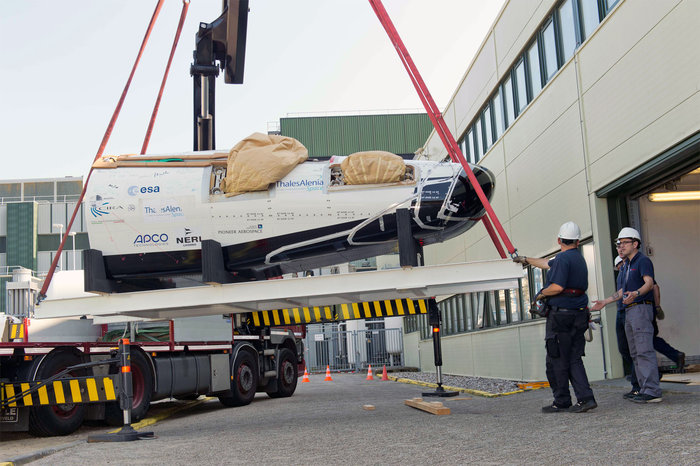
This drop-test model of ESA’s Intermediate eXperimental Vehicle (IXV) spaceplane will be one of the star attractions of the Sunday, 5 October ESTEC Open Day.
This replica was built to be dropped from a helicopter and parachuted into the Mediterranean, to ensure the flight model would survive splashdown at the end of its plunge from space.
The actual spaceplane will fly on a Vega launcher this November, coasting as high as 450 km before gliding back to Earth. In the process, it will gather valuable data on atmospheric reentry conditions.
The flight model was, until this week, being tested for space only a few tens of metres away from its drop-test twin, within the cleanroom environment of the ESTEC Test Centre.
With its test programme complete, it has now been flown to Europe’s Spaceport in French Guiana to begin its launch campaign.
Having been designed for a sea splashdown, the drop-test model can readily withstand the Dutch weather. Visitors can view it in its new position outside the Test Centre throughout the Open Day.
Quelle: ESA
.
Update: 30.09.2014
.
Europe’s IXV spaceplane is welcomed in French Guiana for its Vega launch
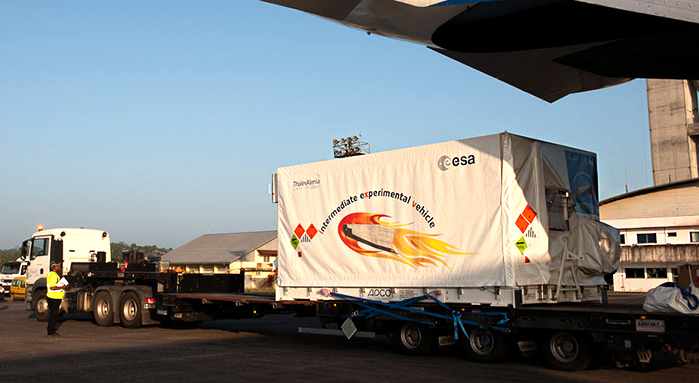
As part of its early morning unloading process in French Guiana, the Intermediate eXperimental Vehicle (IXV) is shown after being rolled off the Antonov cargo aircraft’s ramp onto a flatbed trailer – which will be used for the European spaceplane’s transfer by road to the Spaceport.
.
Vega Flight VV04
Activities for the next flight of Arianespace’s light-lift Vega are now fully underway following delivery of the Intermediate eXperimental Vehicle (IXV) payload to French Guiana – joining the mission’s launcher, which also is advancing in its preparations.
The IXV spaceplane – produced by Thales Alenia Space for the European Space Agency (ESA) – was transported by an Antonov cargo aircraft to Félix Eboué International Airport, located near French Guiana’s capital city of Cayenne. Following the arrival, it was unloaded this morning just after dawn for transfer by road to the Spaceport.
Scheduled for a mid-November liftoff with its Vega launcher, IXV is an atmospheric reentry demonstrator that is designed to flight test technologies and critical systems for Europe’s future automated reentry systems as they return from low Earth orbit.
The research and industrial community will have an opportunity to use the data collected by IXV for progress in atmospheric reentry, oriented towards transportation systems with applications in exploration, science, Earth observation, microgravity and clean space.
November’s Vega mission with IXV is designated Flight VV04 in Arianespace’s numbering system, signifying the launcher’s fourth mission to be performed from the Spaceport. It also will mark Vega’s second flight within the ESA-managed VERTA (Vega Research and Technology Accompaniment) program to showcase this vehicle's flexibility.
Quelle: arianespace
.
Update: 7.10.2014
.
SETTING SAIL FOR ESA SPACEPLANE RECOVERY
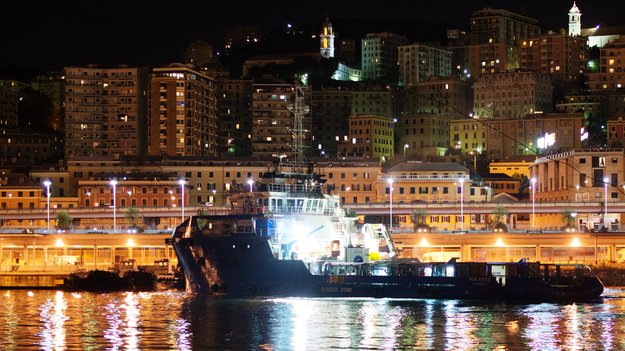
The boat that will lift ESA’s unmanned IXV spaceplane out of the Pacific Ocean after the research flight next month set sail on Saturday from Genoa in Italy.
The Nos Aries received a special send-off at the 54th International boat show in Genoa as it began its long journey across the Mediterranean Sea and the Atlantic.
A team of mission engineers will board in Panama and from there sail through the Panama Canal and into the Pacific.
First, they will check the ship’s antenna and telemetry receivers are working properly after the long journey. The autotracking of the antenna that will pick up the signals from the Intermediate eXperimental Vehicle on its flight back to Earth will be checked by following low-orbit satellites.
Although the team have already practised the tricky manoeuvre of lifting IXV out of the ocean, they will continue to hone their skills under a wide range of conditions.
Nos Aries, the Mission Control Centre in Turin and ESA’s Spaceport in Kourou, French Guiana will be linked up via Inmarsat satellite for IXV mission simulations using voice, data and video.
The crew will also take part in a dress rehearsal of the launch, three days before the actual liftoff.
The ship will reach its destination four days before the flight, slightly north of the equator, on a circle 25 km from the target landing spot. This distance guarantees the safety of the ship while allowing maximum telemetry reception and rapid access to IXV after splashdown.
On flight day, the ship will release weather balloons to check the wind conditions over the Pacific to provide information on IXV’s descent path.
If sea conditions allow the launch to go ahead, Nos Aries will receive the readings from IXV’s 300 sensors during descent and then pick up the beacon signals to pinpoint the craft in the water.
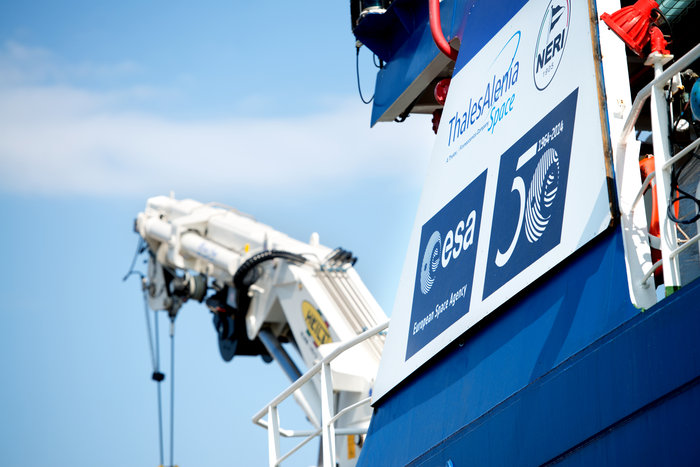
Divers in speedboats will approach the floating craft and then stand back as sniffer devices check for residual propellant fumes. On the all-clear, the recovery cranes will carefully hoist IXV to safety before the fuel tank is cleaned out for the journey home to Europe.
Lofted by a Vega rocket, IXV will test the technologies and critical systems for Europe’s future automated reentry vehicles returning from low orbit.
On the 23 June 2014 a prototype of the suborbital IXV Intermediate eXperimental Vehicle was recovered off the coast of Tuscany, Italy in a practice run for the launch of the real spacecraft in November.
A crane dropped the two-tonne vehicle into the water for the crew to practise the tricky manoeuvres. The rehearsal even allowed for an upside-down splashdown.
Quelle: ESA
.
Update: 10.10.2014
.
Another Vega launcher takes shape at the Spaceport
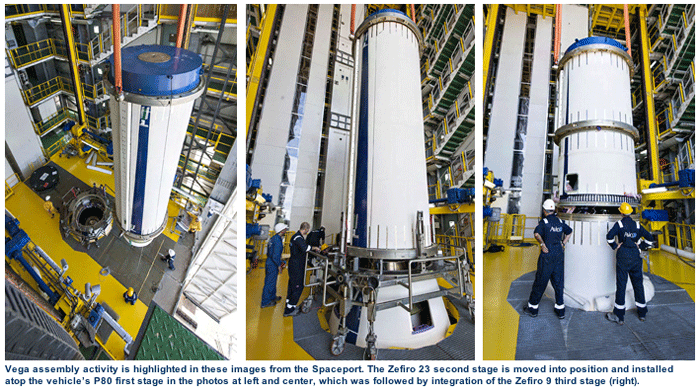
Vega Flight VV04
The Spaceport’s SLV launch site in French Guiana is busy with activity as the fourth lightweight Vega is readied for its mission with Europe’s Intermediate eXperimental Vehicle (IXV) spaceplane.
Build-up of this smallest member in Arianespace’s launcher family is being performed in a vertical assembly process on the SLV launch pad, protected by a mobile gantry that will be withdrawn prior to the vehicle’s liftoff. In the latest integration step this week, Vega’s Zefiro 9 solid propellant third stage was installed atop its lower two solid propellant stages – which were stacked during earlier preparations.
The mission’s IXV passenger – built by Thales Alenia Space for the European Space Agency (ESA) – is an atmospheric reentry demonstrator designed to flight test technologies and critical systems for Europe’s future automated reentry systems as they return from low Earth orbit.
.
Quelle: arianespace
.
Update: 16.10.2014
.
Vega Flight VV04
With the integration of its AVUM upper stage, Vega’s basic build-up is complete for Arianespace’s upcoming light-lift mission with Europe’s Intermediate eXperimental Vehicle (IXV) spaceplane.
As part of Vega’s vertical assembly process on the launch pad, the vehicle’s AVUM (Attitude and Vernier Upper Module) – which uses liquid bi-propellant for primary maneuvering, along with cold gas for attitude control – was hoisted and mated to the three lower solid propellant stages.
This activity occurred at the Spaceport’s SLV launch site – originally used for Ariane 1 and Ariane 3 missions, with its mobile gantry, launch pad and infrastructure updated and adapted for Arianespace’s new lightweight vehicle.
The European Space Agency’s IXV atmospheric reentry demonstrator – built by Thales Alenia Space – is designed to flight test technologies and critical systems for Europe’s future automated reentry systems as they return from low Earth orbit.
Quelle: arianespace
.
Update: 25.10.2014
.
Vega VV04 launch of IXV reentry demonstrator postponed
Evry, October 24, 2014
Within the scope of its preparations for the VV04 mission, the European Space Agency (ESA), in conjunction with French space agency CNES, has decided to carry out additional flight trajectory analyses for the scheduled Vega launch of IXV.
The launch, originally scheduled for November 18, 2014, has therefore been postponed to allow the time needed to complete these analyses.
A new launch date will be announced as soon as possible.
The timetable for the following launches will not change.
Quelle: arianespace
.
Update: 21.11.2014
.
Vega VV04 launch of IXV is scheduled for February 11, 2015
Evry, November 21, 2014
Based on joint work by ESA and CNES, the date for the IXV mission to be launched by Vega has been set for February 11, 2015.
Arianespace will resume launch preparations in early 2015.
Quelle: arianespace
.
Update: 15.01.2015
.
IXV READY FOR LAUNCH
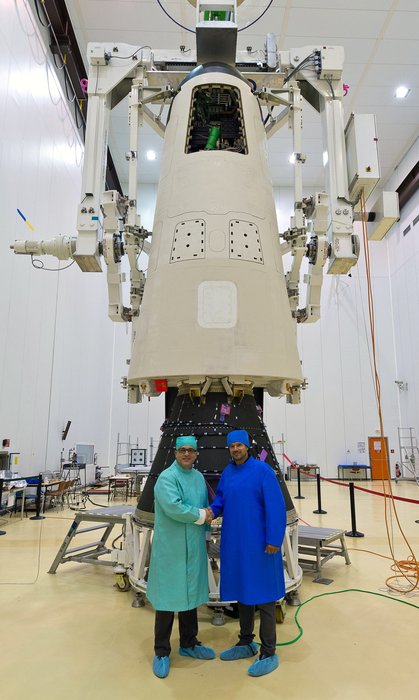
On its first launch of the year, Europe’s Vega rocket will loft ESA’s unmanned spaceplane to test reentry technologies for future vehicles.
The launch campaign has resumed, aiming for a liftoff on 11 February from Kourou, French Guiana to release ESA’s Intermediate eXperimental Vehicle, IXV, into a suborbital trajectory. Batteries that were removed from IXV are being taken from cold storage, charged and reinstalled.
This mission will provide vital flight data for Europe to forge ahead in developing systems and advanced technologies for transportation systems of the future.
Pictured: Giorgio Tumino, ESA's IXV Programme Manager with Davide Nicolini, ESA Vega Operational Launch System Project Manager.
.
On its first launch of the year, Europe’s Vega rocket will loft ESA’s unmanned spaceplane to test reentry technologies for future vehicles.
The launch campaign has resumed, aiming for a liftoff on 11 February from Kourou, French Guiana to release ESA’s Intermediate eXperimental Vehicle, IXV, into a suborbital trajectory.
This mission will provide vital flight data for Europe to forge ahead in developing systems and advanced technologies for transportation systems of the future.
On 23 October, the decision to postpone the launch was taken by the launch authorities as a result of safety concerns that required additional analysis. Finding an alternative trajectory solved the issue.
“Launch preparations have resumed,” said Jose-Maria Gallego Sanz, ESA’s IXV launch campaign manager. “Batteries that were removed from IXV are being taken from cold storage, charged and reinstalled. No additional tests are needed – IXV is ready to fly.”
The mission will last 100 minutes from liftoff to splashdown. Weighing around two tonnes and the size of a car, IXV is a snug fit inside Vega’s protective fairing. The two-piece shell will open to release the spaceplane at an altitude of 320 km.
IXV will coast to up to 420 km and then begin its reentry phase, recording a vast amount of data from a large number of conventional and advanced sensors.
The entry speed of 7.5 km/s at an altitude of 120 km will create the same conditions as those for a vehicle returning from low orbit. IXV will glide through the atmosphere at hypersonic speeds to test new European reentry technologies before parachutes deploy to slow the descent for a safe splashdown in the Pacific Ocean.
The Nos Aries recovery vessel is now stationed in Flamenco Island Anchorage in Panama. Over the last month, the crew have been testing the equipment for hoisting IXV out of the water.
ESA’s recovery team will board on 25 January for the ship to set sail on the last leg of its journey to the recovery spot.
Quelle: ESA
